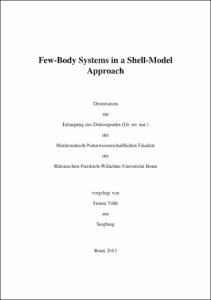Few-Body Systems in a Shell-Model Approach

Few-Body Systems in a Shell-Model Approach

| dc.contributor.advisor | Hammer, Hans-Werner | |
| dc.contributor.author | Tölle, Simon | |
| dc.date.accessioned | 2020-04-19T19:29:52Z | |
| dc.date.available | 2020-04-19T19:29:52Z | |
| dc.date.issued | 14.03.2014 | |
| dc.identifier.uri | https://hdl.handle.net/20.500.11811/6040 | |
| dc.description.abstract | In this thesis, I introduce and compare an implementation of two different shell models for physical systems consisting of multiple identical bosons. In the main part, the shell model is used to study the energy spectra of bosons with contact interactions in a harmonic confinement as well as those of unconfined He clusters. The convergence of the shell-model results is investigated in detail as the size of the model space is increased. Furthermore, possible improvements such as the smearing of contact interactions or a unitary transformation of the potentials are utilised and assessed. Systems with up to twelve bosons are considered. Moreover, I test a procedure to determine scattering observables from the energy spectra of fermions in a harmonic confinement. Finally, the position and width of resonances are extracted from the dependence of the energy spectra on the oscillator length. | en |
| dc.description.abstract | Im Rahmen dieser Arbeit werden zunächst Implementierungen zweier verschiedener Schalenmodelle zur Bestimmung von Bindungsenergien in bosonischen Mehrteilchensystemen vorgestellt und verglichen. Schwerpunktmäßig verwende ich das Schalenmodell zur Beschreibung von Bosonen mit Kontaktwechselwechselwirkungen, die in einem Oszillatorpotential eingesperrt sind, als auch für wechselwirkende He-Atome und ihre Clusterbildung. Ausgiebig werden Abhängigkeiten der Resultate im Schalenmodell von seiner Modellraumgröße untersucht und Möglichkeiten geprüft, eine schnellere Konvergenz zu erreichen; wie etwa ein Verschmieren der Kontaktkräfte sowie eine unitäre Transformation der Potentiale. Hierbei werden Systeme betrachtet, die maximal aus zwölf Bosonen bestehen. Zusätzlich wird ein Verfahren zur Bestimmung von Streuobservablen anhand von Energiespektren von Fermionen im harmonischen Oszillator vorgestellt und geprüft. Schlussendlich werden anhand der Abhängigkeit von Energiespektren von der Oszillatorbreite Position und Breite von Streuresonanzen extrahiert. | en |
| dc.language.iso | eng | |
| dc.rights | In Copyright | |
| dc.rights.uri | http://rightsstatements.org/vocab/InC/1.0/ | |
| dc.subject | Helium | |
| dc.subject | Cluster | |
| dc.subject | Fallen | |
| dc.subject | universell | |
| dc.subject | Bosonen | |
| dc.subject | Spektrum | |
| dc.subject | trap | |
| dc.subject | universal region | |
| dc.subject | bosons | |
| dc.subject | spectrum | |
| dc.subject.ddc | 530 Physik | |
| dc.title | Few-Body Systems in a Shell-Model Approach | |
| dc.type | Dissertation oder Habilitation | |
| dc.publisher.name | Universitäts- und Landesbibliothek Bonn | |
| dc.publisher.location | Bonn | |
| dc.rights.accessRights | openAccess | |
| dc.identifier.urn | https://nbn-resolving.org/urn:nbn:de:hbz:5n-35150 | |
| ulbbn.pubtype | Erstveröffentlichung | |
| ulbbnediss.affiliation.name | Rheinische Friedrich-Wilhelms-Universität Bonn | |
| ulbbnediss.affiliation.location | Bonn | |
| ulbbnediss.thesis.level | Dissertation | |
| ulbbnediss.dissID | 3515 | |
| ulbbnediss.date.accepted | 10.02.2014 | |
| ulbbnediss.fakultaet | Mathematisch-Naturwissenschaftliche Fakultät | |
| dc.contributor.coReferee | Metsch, Bernard Ch. |
Dateien zu dieser Ressource
Das Dokument erscheint in:
-
E-Dissertationen (4405)




